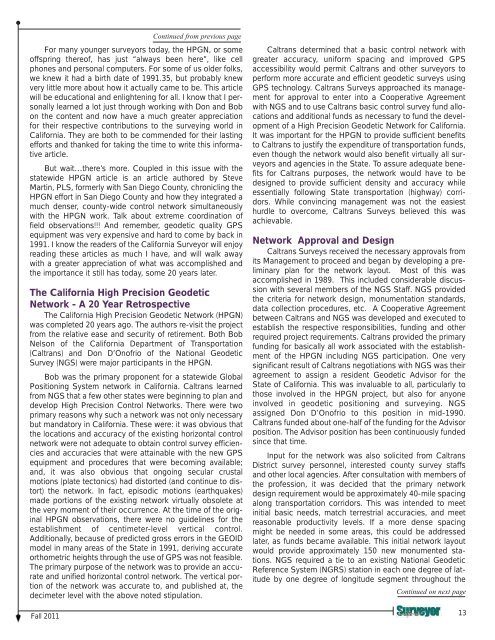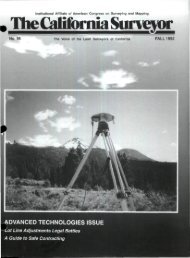Create successful ePaper yourself
Turn your PDF publications into a flip-book with our unique Google optimized e-Paper software.
Fall 2011<br />
Continued from previous page<br />
For many younger surveyors today, the HPGN, or some<br />
offspring thereof, has just “always been here”, like cell<br />
phones and personal computers. For some of us older folks,<br />
we knew it had a birth date of 1991.35, but probably knew<br />
very little more about how it actually came to be. This article<br />
will be educational and enlightening for all. I know that I personally<br />
learned a lot just through working with Don and Bob<br />
on the content and now have a much greater appreciation<br />
for their respective contributions to the surveying world in<br />
California. They are both to be commended for their lasting<br />
efforts and thanked for taking the time to write this informative<br />
article.<br />
But wait…there’s more. Coupled in this issue with the<br />
statewide HPGN article is an article authored by Steve<br />
Martin, PLS, formerly with San Diego County, chronicling the<br />
HPGN effort in San Diego County and how they integrated a<br />
much denser, county-wide control network simultaneously<br />
with the HPGN work. Talk about extreme coordination of<br />
field observations!!! And remember, geodetic quality GPS<br />
equipment was very expensive and hard to come by back in<br />
1991. I know the readers of the California Surveyor will enjoy<br />
reading these articles as much I have, and will walk away<br />
with a greater appreciation of what was accomplished and<br />
the importance it still has today, some 20 years later.<br />
The California High Precision Geodetic<br />
Network - A 20 Year Retrospective<br />
The California High Precision Geodetic Network (HPGN)<br />
was completed 20 years ago. The authors re-visit the project<br />
from the relative ease and security of retirement. Both Bob<br />
Nelson of the California Department of Transportation<br />
(Caltrans) and Don D’Onofrio of the National Geodetic<br />
Survey (NGS) were major participants in the HPGN.<br />
Bob was the primary proponent for a statewide Global<br />
Positioning System network in California. Caltrans learned<br />
from NGS that a few other states were beginning to plan and<br />
develop High Precision Control Networks. There were two<br />
primary reasons why such a network was not only necessary<br />
but mandatory in California. These were: it was obvious that<br />
the locations and accuracy of the existing horizontal control<br />
network were not adequate to obtain control survey efficiencies<br />
and accuracies that were attainable with the new GPS<br />
equipment and procedures that were becoming available;<br />
and, it was also obvious that ongoing secular crustal<br />
motions (plate tectonics) had distorted (and continue to distort)<br />
the network. In fact, episodic motions (earthquakes)<br />
made portions of the existing network virtually obsolete at<br />
the very moment of their occurrence. At the time of the original<br />
HPGN observations, there were no guidelines for the<br />
establishment of centimeter-level vertical control.<br />
Additionally, because of predicted gross errors in the GEOID<br />
model in many areas of the State in 1991, deriving accurate<br />
orthometric heights through the use of GPS was not feasible.<br />
The primary purpose of the network was to provide an accurate<br />
and unified horizontal control network. The vertical portion<br />
of the network was accurate to, and published at, the<br />
decimeter level with the above noted stipulation.<br />
Caltrans determined that a basic control network with<br />
greater accuracy, uniform spacing and improved GPS<br />
accessibility would permit Caltrans and other surveyors to<br />
perform more accurate and efficient geodetic surveys using<br />
GPS technology. Caltrans Surveys approached its management<br />
for approval to enter into a Cooperative Agreement<br />
with NGS and to use Caltrans basic control survey fund allocations<br />
and additional funds as necessary to fund the development<br />
of a High Precision Geodetic Network for California.<br />
It was important for the HPGN to provide sufficient benefits<br />
to Caltrans to justify the expenditure of transportation funds,<br />
even though the network would also benefit virtually all surveyors<br />
and agencies in the State. To assure adequate benefits<br />
for Caltrans purposes, the network would have to be<br />
designed to provide sufficient density and accuracy while<br />
essentially following State transportation (highway) corridors.<br />
While convincing management was not the easiest<br />
hurdle to overcome, Caltrans Surveys believed this was<br />
achievable.<br />
Network Approval and Design<br />
Caltrans Surveys received the necessary approvals from<br />
its Management to proceed and began by developing a preliminary<br />
plan for the network layout. Most of this was<br />
accomplished in 1989. This included considerable discussion<br />
with several members of the NGS Staff. NGS provided<br />
the criteria for network design, monumentation standards,<br />
data collection procedures, etc. A Cooperative Agreement<br />
between Caltrans and NGS was developed and executed to<br />
establish the respective responsibilities, funding and other<br />
required project requirements. Caltrans provided the primary<br />
funding for basically all work associated with the establishment<br />
of the HPGN including NGS participation. One very<br />
significant result of Caltrans negotiations with NGS was their<br />
agreement to assign a resident Geodetic Advisor for the<br />
State of California. This was invaluable to all, particularly to<br />
those involved in the HPGN project, but also for anyone<br />
involved in geodetic positioning and surveying. NGS<br />
assigned Don D’Onofrio to this position in mid-1990.<br />
Caltrans funded about one-half of the funding for the Advisor<br />
position. The Advisor position has been continuously funded<br />
since that time.<br />
Input for the network was also solicited from Caltrans<br />
District survey personnel, interested county survey staffs<br />
and other local agencies. After consultation with members of<br />
the profession, it was decided that the primary network<br />
design requirement would be approximately 40-mile spacing<br />
along transportation corridors. This was intended to meet<br />
initial basic needs, match terrestrial accuracies, and meet<br />
reasonable productivity levels. If a more dense spacing<br />
might be needed in some areas, this could be addressed<br />
later, as funds became available. This initial network layout<br />
would provide approximately 150 new monumented stations.<br />
NGS required a tie to an existing National Geodetic<br />
Reference System (NGRS) station in each one degree of latitude<br />
by one degree of longitude segment throughout the<br />
Continued on next page<br />
13
















